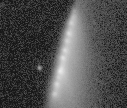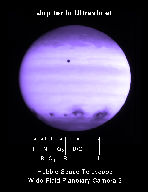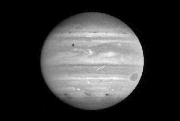Pictures found on Internet: impact on Jupiter
In July 1994 the remains of the comet Shoemaker-Levy 9 collided with
the giant planet Jupiter, resulting in spactacular effects.
Here I show 3 of the mant pictures I collected, coming mainly from the
Space Telescope Science
Institute (STScI), Baltimore (USA).
 (142 kb)
(142 kb)
This is an image obtained with the 2.3-meter telescope of the University
of Arizona Observatories on Kitt Peak in Arizona by Wieslaw Wisniewski
on 1993 March 28 at a mid-time of 06:45:32 UT. The total integration
time was 300 seconds. North is to the right and East is at the top.
The field of view is 1.3 arcminutes square. This is a close-up of the
nuclear train showing at least 12 individual nuclei embedded within.
Notice that the southern boundary of the nuclear train is very sharp
compared to the northern boundary.
 (100 kb)
(100 kb)
Ultraviolet image of Jupiter taken by the Wide Field Camera of the
Hubble Space Telescope. The image shows Jupiter's atmosphere at a
wavelength of 2550 Angstroms after many impacts by fragments of comet
Shoemaker-Levy 9. The most recent impactor is fragment R which is
below the center of Jupiter (third dark spot from the right). This
photo was taken 3:55 EDT on July 21, about 2.5 hours after R's impact.
A large dark patch from the impact of fragment H is visible rising on
the morning (left) side. Proceding to the right, other dark spots were
caused by impacts of fragments Q1, R, D and G (now one large spot), and
L, with L covering the largest area of any seen thus far. Small dark
spots from B, N, and Q2 are visible with careful inspection of the
image. The spots are very dark in the ultraviolet because a large
quantity of dust is being deposited high in Jupiter's stratosphere, and
the dust abosrbs sunlight. Scientists will be able to track winds in
the stratosphere by watching the evolution of these
Credit: Hubble Space Telescope Comet Team
 (43 kb)
(43 kb)
This image of Jupiter was obtained with a filter at 336 nm
(near-ultraviolet light) at 18:42 UT on 17 July 1994. Three impact
sites (from left to right: C, A, and E) are visible as dark spots
across the lower portion of the image. All other features in this
picture are characteristic of Jupiter's normal state. The feature
created by the impact of A is 23 hours old in this image. The C and E
features are 12 and 5 hours old, respectively. Io is seen as a dark
spot in the northern hemisphere (on the left) and the red spot is
visible on the right limb.
Credit: The Hubble Space Telescope Jupiter Imaging Team
<=== main page of pictures found on Internet.
 Jos van Geffen --
Home |
Site Map |
Contact Me
Jos van Geffen --
Home |
Site Map |
Contact Me
created: 31 July 1995
last modified: 8 March 2000
 (142 kb)
(142 kb)
 (100 kb)
(100 kb) (43 kb)
(43 kb) Jos van Geffen
Jos van Geffen